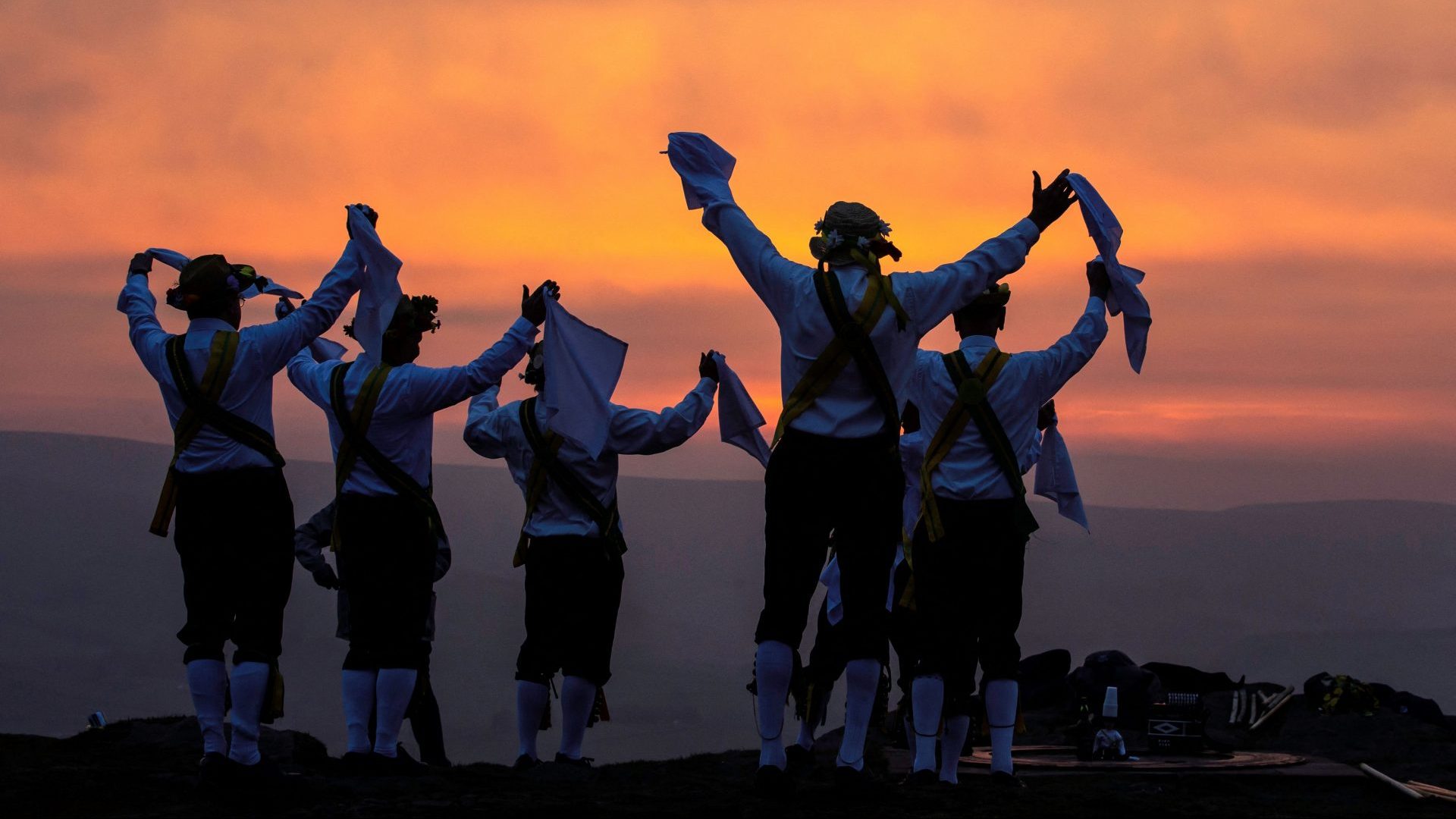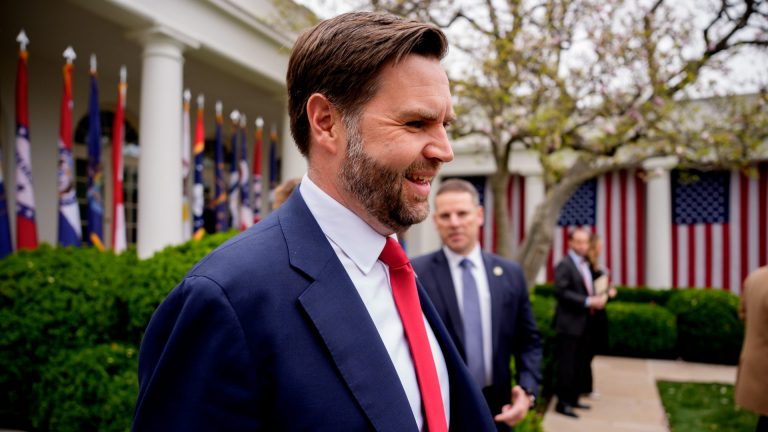When Morris dancing took centre stage at the Brit Awards earlier this year, the moment arguably became real. Cool Britannia was toast. Merrie England had taken over.
The signs are everywhere, not just on the village green and in Ye Olde Timbered Inn, way out in the sticks. At the Brits, the all-girl Boss Morris troupe of Morris Dancers accompanied Grammy-winning indie band Wet Leg in mini-dresses. Up and down the land, nearly 14,000 other Morris dancers cavort most weekends with energy and abandon.
Countless wassails are being held. That ancient English ritual involves mulled cider or ale, and songs that implore the pagan gods for bountiful harvests. There are riotous “Jack in the Green” spring parades. The one in Hastings, south-east England, attracted its largest audience last year in nearly half a century. Mummers plays, traditional Christmas-time dramas, themed around death and resurrection, tour villages in Oxfordshire and further afield. Even the National Trust heritage conservation body is putting these on.
Plough pudding, heavy with suet and sausage meat from Norfolk recipes hundreds of years old, feature on the Sainsbury’s website. English Heritage, the charity that manages more than 400 historic sites to bring “the story of England to life”, has more paid members today than at any time in its history.
A weighty 530-page tome on Morris dance is published on March 30.
And the UK recently got its first exhibition of local folk costume, which will move to London next year from Compton Verney, a Georgian mansion in rural Warwickshire.
“Diverse groups of people are participating in English folk traditions and we’re very, very excited about that,” says Eliza Carthy, head of the non-profit English Folk Dance and Song Society (EFDSS), which champions the traditional arts. Carthy, often described as the uncrowned queen of English folk, is the daughter of iconic folk musicians Norma Waterson and Martin Carthy. Her father influenced Bob Dylan and taught Paul Simon to play Scarborough Fair. Having joined the Goathland Plough Stots, a century-old northern Yorkshire side (the correct term for a Morris troupe) aged 13, Carthy says she is excited by the current “wonderful surge” in the popularity of the dance. Back in the late 1980s, the Stots had eight dancers and two musicians, one of whom was Carthy; now it has at least 30 dancers and 12 musicians. Now president of the EFDSS and a professional touring musician, Carthy says she is witness to the “upsurge across the country in all forms of Morris dancing, with lots of young people joining. This isn’t just a post-Covid thing, let’s be clear about that.”
Ronald Hutton, one of Britain’s foremost historians, agrees that there has been a boom in some English folk customs over the past five to 10 years. “When I wrote a book in the 1990s, there were only three places left in Britain that wassailed,” he remembers. “There are now scores advertised on the internet alone.”
It chimes with what the cultural geographer Edward Wigley found in his 2019 research. The wassail is increasingly popular “in built-up areas, often with little or no history of fruit farming,” he reported. One such is a historic park in a gritty part of Greenwich in London where the historian and storyteller Rich Sylvester has organised a wassail for a decade. Every year, he says, he dons his “holly top-hat” and snatches up an environmentally conscious simulation of a microphone – a hazel stick with an apple at its end – to compere the event. Featuring a Brazilian drummer and a Morris side that includes an Indonesian dancer, the wassail draws a cosmopolitan local crowd.
Hutton says the folk boom extends to the Mari Lwyd, a custom in which a horse figure is carried door to door by wassail-singing groups. There is also Padstow’s ’Obby ’Oss festival, a Cornish event that’s thought to have pre-Christian roots and which now attracts tens of thousands of tourists. The Abbots Bromley Horn Dance, a Staffordshire village romp dating back to the Middle Ages, is newly popular. As is Chester’s revival of the medieval Winter Watch and the Saturnalia Parade, which goes even further back. “Looking back to the traditions of yesteryear is a way of rekindling a simpler life,” says Dee Dee Chainey, co-founder of the online magazine #FolkloreThursday.
Chainey, whose 2018 book A Treasury of British Folklore: Maypoles, Mandrakes and Mistletoe inspired the National Trust to start a folklore trail at one of its 900-year-old properties, sees folklore being “reinvented as a tool” today.
But a tool for what purpose? As Simon Costin, who organised the Compton Verney costume exhibition asked, why is “British folklore and vernacular culture having a moment right now”?
Costin, a former Alexander McQueen collaborator, founded the Museum of British Folklore in 2009. Today, he sees the folk revival as an expression of youthful yearning in a churning, confused world. “Young people aren’t religious, but they’re looking for meaning in something that has some element of spirituality. That’s what folklore has,” he says.
James Merryclough, an older millennial who dances with two Morris sides in Sheffield, says young people see folk customs “as a counterculture”. As “unofficial spokesman” for the Morris Federation, one of three umbrella organisations that enfold the UK’s estimated 800 Morris sides, Merryclough himself reflects the growing popularity of the dance. With no background in Morris, he took it up 10 years ago after moving to Sheffield and breaking up with a girlfriend. “Now, my two-year-old son does Morris around the living room,” he says, “and all the folk festivals now have Morris workshops for kids. The next generation will probably know more about Morris than mine.”
Many of the nearly 30 Morris dancers, wassailers, art curators, folk musicians, folklorists, historians, traditional horticulturists and heritage officials interviewed by the New European offered overlapping views of the ongoing revival. It’s about finding a sense of community in multicultural Britain, they said, claiming your sense of place, connecting with the land, reconnecting to the seasonal rhythms of where you live, and crucially, conservation.
Morris-dancing BBC Radio 2 producer Julian May says it is a move away from passive consumption to “something you make yourself”, akin to the current revival of knitting, and the rise of community choirs.
Hutton says “the celebration of the seasons and of communal activity are a very good way [to feel] linkedness”.
Sam Lee, who uses folk music to promote love of the natural world through his sell-out springtime immersive experiences “Singing with Nightingales”, says old customs are “a reawakening, permission, a sense we have the right to know and love this land”. This is not about “Merrie England”, he cautions, in reference to the utopian idea that English life between the Middle Ages and the industrial revolution was a pastoral idyll. “It is a melancholy, woeful, broken England that we are doing healing work on.”
Matt Thompson, head collections curator at English Heritage, with whom Lee did a YouTube folk series called Songs of England, says his organisation has “a clear recognition folk has value as the wider story of England.”
But why now? Why is Britain so keen today to tell that wider story, one that goes much further back than the British empire?
“Empire was a very short-lived phenomenon, lasting just about 100 years,” says Hutton, “whereas Britain as a joint enterprise has been around for about 300 and England for about 1100.” He describes Britain’s unique problem today as the great power status attached to its name, along with the knowledge there is no “easy, obvious and straightforward way out of a situation in which we are having to find a new role in the world, while at the same time having one of the largest armies and navies, one of the largest economies and a seat on the security council of the United Nations.”
In his 2003 book The British Folk Revival, which covered the period after the second world war, Liverpool-born-and-bred Michael Brocken, who holds a doctorate in popular music, discerned something similar. There were “uncertainties concerning Britain’s international profile and imperial development,” he wrote. In the past 20 years, that anxiety has worsened.
Julian May says: “With our place in the world not what it was, I think we are beginning to look at who we are and what we want to be.”
Michael Heaney, a dedicated Morris dancer, melodeon-player and author of the newly published The Ancient English Morris Dance agrees. “Britain’s much smaller role in the world is forcing us to look more closely at what it is to be British or English,” he says. Heaney, who retired a few years ago from Oxford’s Bodleian Library, adds: “When the English looked upon themselves as the dominant force in the world, everybody else was supposed to have ethnic merit, but not the English.”
This imperial mode is described in the historian Laura Carter’s 2017 eponymous paper on rethinking folk culture in 20th-century Britain: “English folk objects and customs were explained as ‘survivals’ of earlier, less civilised cultures.”
Carthy laments the long period in which “people’s minds were blown by the idea that the English might have an ancient culture of song and dance and ritual costume”. Fortunately, that’s changing, and “it is important to be able to talk about your history and your culture and your heritage without feeling any embarrassment”.
The folk tribe as a whole agrees this embarrassment about an English ethnic culture has resulted in continual “disparagement” and great “mockery” of traditional customs and those who practise them. It’s why Sebastian Coe, chair of the 2012 London Olympics organising committee, was able to make a joke about having 5,000 Morris dancers at the Games’ opening ceremony. May was furious. “It was typical of the attitude of people in power that England’s traditional culture is always considered a kind of a joke. Well, it’s not.”
May felt so offended that he collaborated with well-known comedian Stewart Lee on a Radio 2 show about English traditional dances. It was very successful, he says with some satisfaction. “Everyone thought it would be a piss-take. But I knew Stewart was interested in this stuff and had Morris dancers at his wedding. Look, we’re not just a lot of fat, bald old men drinking beer.”
Other Morris dancers also challenge the stereotype that they are “little Englanders and Brexiteer types”. But fear of being claimed by any narrow “ism” continually ripples through the folk fraternity. Thompson of English Heritage warns against the assumption “that older equals authentic because you can set up in-groups and out-groups”. Chainey notes that folk and mythology have always been deployed “to ‘other’ those that are seen as coming from outside of these traditions.”
Some years ago, Morris sides were forced to push back against the British National Party (BNP). More recently, there was a row over Patriotic Alternative, which emerged from BNP splits and which seeks to present itself as an organisation concerned about the environment and heritage.
Carthy, who appeared at a noughties gig organised early on by the Folk against Fascism campaign, says the English Folk Dance and Song Society’s London headquarters makes its space available to diverse cultural traditions practised in Britain, such as Indian bhangra. The University of Sheffield recently held Access Folk, a symposium on ways to make English folk more inclusive. Merryclough, whose Morris side includes a young Croatian woman and has seen a flicker of interest from an Iranian and a Peruvian, says more must be done. “After all, we’re not a historical re-enactment. We’re not trying to uphold some idealised vision of Englishness, and certainly not nationalism.”
But Sam Lee insists that almost everyone, “a recent migrant or one from much before”, knows they can lay claim to Britain’s story. He recounts a recent night spent in a youth hostel in the Peak district, on his way to a gig in Buxton. Falling into conversation with the man in the next bed, Lee learned that he was Bangladeshi, had arrived in Britain 10 years ago and that both men had, separately, visited the 25,000-year-old Thor’s Cave. “You know what he said to me,” Lee continued, “he said, ‘Isn’t it amazing to think that our ancestors were once there?’ It felt very nice to hear that.”











